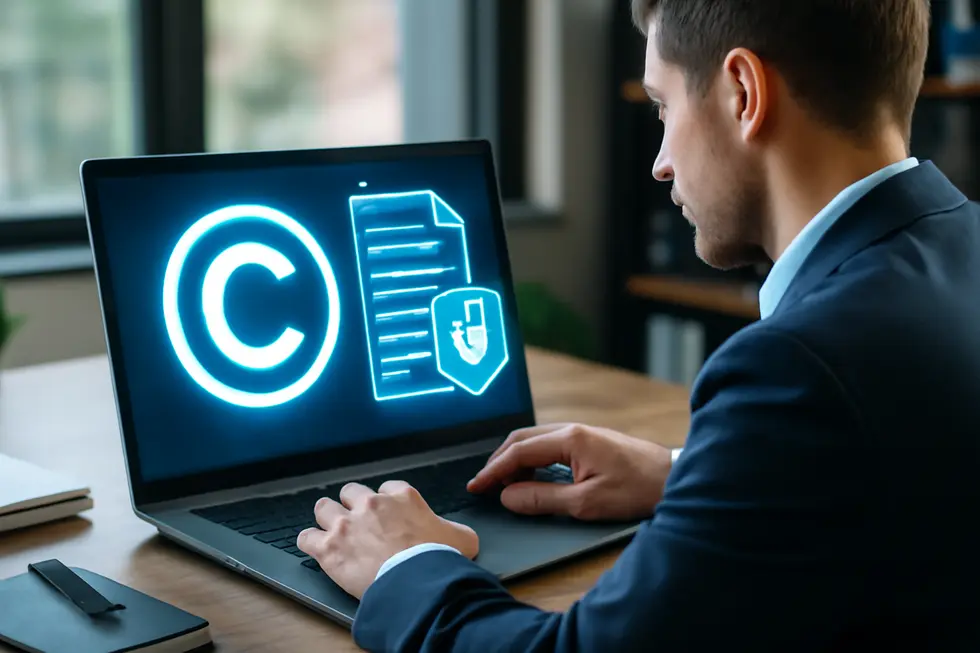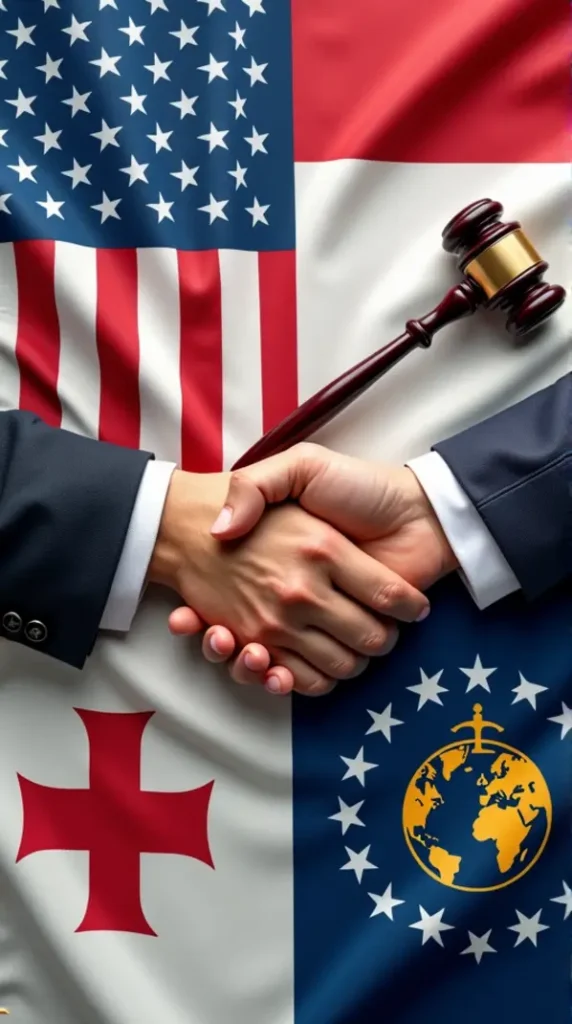Introduction
Copyright protection is a vital aspect for businesses that rely on original online content. Displaying a clear and legally effective copyright notice on your website not only signals ownership but also deters unauthorized use of your intellectual property. This article guides business owners through the core components of a copyright notice, explores its legal advantages under U.S. law, highlights the importance of formal copyright registration, explains how to establish detailed usage restrictions, and sets out best practices for implementation and enforcement. Each chapter builds on the last to provide a comprehensive understanding of how a copyright notice website can safeguard your business’s digital assets.
Tables of Contents
Chapter 1: Essential Elements of a Copyright Notice Website
- Integrating Digital Technologies to Fortify Website Copyright Notices
- Economic Significance and Protective Benefits of Copyright Notices on Websites
- Bridging Legal Mandates and Societal Respect: The Role of Copyright Notices on Websites
Chapter 2: Legal Benefits of a Copyright Notice Website Under U.S. Law
- How Copyright Notices Serve as Powerful Deterrents and Public Ownership Signals
- How Copyright Notices Strengthen Ownership Claims and Reduce Legal Disputes
- How Copyright Notices Strengthen Legal Protections and Enforcement Online
Chapter 3: Enhanced Protection Through Copyright Registration for a Copyright Notice Website
- Unlocking Legal Strength: How Copyright Registration Empowers Website Owners
- Mastering the Registration Process to Maximize Copyright Protection for Your Website
- Unlocking Economic Value and Legal Power: The Impact of Copyright Registration on Website Protection
Chapter 4: Detailed Usage Restrictions on a Copyright Notice Website
- Clarifying Copyright Ownership and Personal Use Boundaries on Your Copyright Notice Website
- Navigating Prohibited Actions and Fair Use Boundaries in Website Copyright Notices
- Navigating Third-Party Content Licensing and Attribution in Website Usage Restrictions
Chapter 5: Best Practices for Implementing a Copyright Notice Website and Enforcement
- Establishing Clear Ownership and Robust Legal Defenses Through Strategic Copyright Notices
- Integrating Technical Measures and Legal Tools to Strengthen Copyright Protection on Your Website
- Strengthening Website Copyright Protection: From Notice to DMCA and Legal Enforcement
Chapter 1: Essential Elements of a Copyright Notice Website

1. Integrating Digital Technologies to Fortify Website Copyright Notices
The foundation of an effective copyright notice on a website extends beyond mere text; it relies heavily on a sophisticated blend of technological frameworks that ensure clarity, legal compliance, and enforcement capability. At its core, the copyright notice is embedded within the website’s structure using HTML or other markup languages. This ensures the © symbol, publication year, and copyright holder’s name are prominently displayed, typically within the footer, so visitors recognize the ownership immediately.
Modern content management systems (CMS) play a crucial role in maintaining this consistency. These platforms automatically apply copyright information across pages and manage metadata that documents creation dates and ownership details, both vital in establishing originality and protecting intellectual property rights. Version control elements within CMS further support tracking of revisions and updates to content.
Beyond display, technological advancements have introduced automated detection tools designed to uphold copyright enforcement online. Techniques such as digital watermarking and automated fingerprinting scan for unauthorized copies or alterations of original content. Such mechanisms enable website owners to identify infringement rapidly and pursue legal remedies when necessary.
With the emergence of AI-generated content, new moderation algorithms have been integrated to evaluate outputs for potential copyright violations. These systems use similarity detection to prevent unintentional replication of protected works before publication.
Finally, technological integration extends to the registration process itself. National copyright offices provide secure online portals where website owners can upload digital copies of their materials and submit formal registrations quickly, reinforcing legal ownership.
Together, these technological layers transform a simple copyright notice into an active shield of protection. For deeper guidance on the registration process and securing your website’s content, see resources like QuickSprout’s comprehensive guide and explore the importance of copyright protection for all types of creative works.
2. Economic Significance and Protective Benefits of Copyright Notices on Websites
A copyright notice on a website carries substantial economic significance by safeguarding a business’s digital assets and reinforcing legal protections. This notice—composed of the © symbol, publication year, and copyright owner’s name—serves not only as a visible signal of ownership but also as a deterrent to unauthorized use. While copyright protection arises automatically upon creation, displaying a clear notice reduces the chance that infringement will be treated as innocent. This distinction can profoundly affect the scale of damages awarded if legal action ensues.
For businesses, particularly small enterprises and digital creators, unauthorized use of website content can lead to lost revenue and operational disruption. A well-placed copyright notice mitigates this by facilitating faster enforcement measures like DMCA takedown requests, helping to curb ongoing losses and preserve brand reputation. Furthermore, including a copyright notice creates intangible assets that contribute to business valuation and open avenues for monetization through licensing or sales.
Registering copyrights enhances these economic advantages by enabling eligibility for statutory damages and recovery of legal fees in infringement suits—critical tools for offsetting financial harm and discouraging future violations. The presence of a notice also streamlines asserting these rights by clarifying ownership and publication dates.
Beyond immediate protection, leveraging copyright notices aligns with broader intellectual property strategies that protect and enhance brand equity. For businesses seeking to optimize these advantages, understanding the interplay of copyright notices and registration is key to managing risks and capitalizing on digital content assets effectively.
For further insights on the strategic and economic dimensions of copyright notices, see more detailed analysis in the benefits of copyright registration for business and consult comprehensive guides like Copyrighted.com.
3. Bridging Legal Mandates and Societal Respect: The Role of Copyright Notices on Websites
A well-crafted copyright notice on a website serves as both a legal safeguard and a social signal, combining to reinforce ownership and encourage ethical use. Fundamentally, it includes three core components: the copyright symbol © (or equivalent terms like “Copyright” or “Copr.”), the year of first publication, and the name of the copyright owner or an identifiable abbreviation. When these elements appear clearly on website pages—typically in footers—they visibly assert rights to all original content, from text and images to code and multimedia.
Legally, while the U.S. no longer demands a copyright notice for protection, including one informs visitors that the material is protected under copyright law. The symbol and year establish formal notification and a timeline for protection, helping define the boundaries within which the owner’s rights apply. Naming the copyright owner clarifies who controls those rights, guiding users on who to contact for permissions. Although not a substitute for official registration with the Copyright Office, this visible assertion helps deter infringement and limits defenses based on innocent use.
From a societal perspective, the copyright notice fosters respect for intellectual property by making rights obvious to website visitors. This transparency promotes responsible behavior, encouraging users to recognize ownership and avoid unauthorized copying or reuse. It also supports fair competition by preventing misappropriation that might mislead consumers about the origin or endorsement of content. Clear and accessible notices help build trust between creators, businesses, and audiences, contributing to an ethical digital environment.
Practically, placing the notice where users can easily see it—commonly the footer—ensures its effectiveness without disrupting user experience. For visually perceptible digital content, the © symbol applies, signaling that text, images, and video are protected. For additional legal assurance and guidance on usage, adding explicit terms within or near the copyright notice can further define user permissions.
Integrating these elements aligns website design with both legal expectations and societal norms on intellectual property respect. For a comprehensive overview of copyright notice requirements and examples, see the detailed summary on the Wikipedia page on Copyright Notice. To deepen understanding of copyright’s role within business contexts, exploring the benefits of copyright registration for business offers practical insights.
Chapter 2: Legal Benefits of a Copyright Notice Website Under U.S. Law
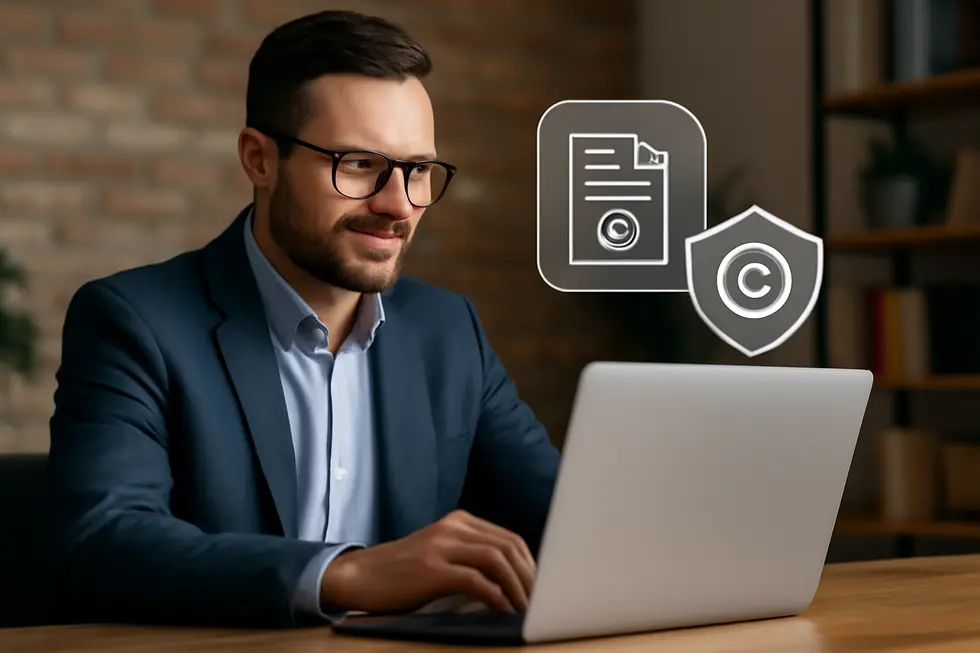
1. How Copyright Notices Serve as Powerful Deterrents and Public Ownership Signals
A well-placed copyright notice on a website performs critical legal functions by openly declaring ownership and deterring potential infringement. While U.S. copyright protection automatically exists when an original creative work is fixed in a tangible form, explicitly displaying a notice informs visitors that the content is protected and that the owner intends to enforce their rights. This public declaration helps prevent accidental infringement and signals that unauthorized use may lead to legal consequences.
The notice clearly identifies the copyright owner and the year the work was first published, establishing a visible record of the claim. This transparency weakens common defenses based on ignorance, such as “innocent infringement,” by demonstrating that users had reasonable notice of protection. From a legal standpoint, this can reduce possible statutory damages if infringement occurs, dropping penalties from tens of thousands of dollars to much lower amounts, unless willful violation is proven.
Moreover, a copyright notice bolsters practical enforcement efforts. It aids website owners in issuing DMCA takedown requests and strengthens their position in court by confirming ownership upfront. Although registering the copyright with the U.S. Copyright Office extends additional legal benefits, such as eligibility for statutory damages and attorney’s fees, simply including a clear copyright notice is an effective and accessible first step toward protecting intellectual property online.
By maintaining an accurate copyright notice, website owners provide unambiguous public notice that deters unauthorized use and enhances legal protections under U.S. law. This foundational practice aligns with broader strategies to safeguard original digital content in an increasingly complex online environment.
For more comprehensive information on how a copyright notice operates, consult the Copyright Notice – Wikipedia.
Additionally, website operators interested in strengthening their intellectual property portfolio can explore the benefits of copyright protection for books, movies, and songs.
2. How Copyright Notices Strengthen Ownership Claims and Reduce Legal Disputes
A copyright notice on a website plays a crucial role in strengthening ownership claims and minimizing legal disputes under U.S. law. Although no longer mandatory, its presence explicitly identifies the copyright owner, reducing confusion over who holds rights to the website’s original content. By stating the year of first publication, the notice also clarifies when copyright protection began, a vital detail for understanding the duration and validity of legal rights.
Displaying a clear notice acts as a visible deterrent against unauthorized copying and use. It signals to visitors that the website’s content—ranging from text and images to code—is protected and actively monitored. This discourages potential infringers by emphasizing legal consequences if unauthorized use occurs. Additionally, if disputes arise, the notice serves as evidence that the copyright holder has publicly asserted ownership, which can critically undermine defenses based on claims of “innocent infringement.” Infringers who argue they were unaware of protection may face higher statutory damages when a notice is in place.
While automatic copyright protection begins upon creation, combining a copyright notice with formal registration magnifies legal protections. Registered works shown with a proper notice facilitate stronger enforcement measures such as Digital Millennium Copyright Act (DMCA) takedown requests, making it easier to assert rights and remove infringing content swiftly. This layered approach not only protects the creator’s interests but also clarifies ownership details for users and third parties alike.
Ultimately, a well-crafted copyright notice is a practical, straightforward tool that enhances legal defenses by clearly communicating ownership and safeguarding intellectual property. For more comprehensive guidance on the benefits of copyright registration, explore resources explaining the benefits of copyright registration for businesses.
For detailed instructions on copyright notices and legal enforcement strategies under current U.S. law, see this expert guide: https://www.quicksprout.com/how-to-copyright-a-website/
3. How Copyright Notices Strengthen Legal Protections and Enforcement Online
A copyright notice on a website serves as a vital instrument to reinforce legal protections, even though U.S. law no longer requires it. By clearly marking content with the © symbol, the publication year, and the copyright owner’s name, the notice communicates an explicit claim of ownership to all visitors. This transparency is crucial in deterring potential infringers, who are less likely to attempt unauthorized use if they recognize the content is protected. The notice thus acts as a front-line defense against infringement by diminishing claims of unawareness, which courts may consider when determining damages.
The presence of a copyright notice also mitigates legal uncertainties by specifying the copyright’s origin year and owner identity, helping to clarify the copyright term and rightful parties. This clarity reduces disputes and strengthens enforcement efforts. In the event of infringement, courts often view a proper notice as evidence supporting the copyright holder’s claim, helping to counter defenses based on innocent infringement or lack of knowledge.
While copyright protection attaches automatically upon fixation of original work, formal registration with the U.S. Copyright Office remains the essential step for accessing full legal remedies, such as suing for infringement, statutory damages, and attorney fees. The copyright notice complements registration by visibly asserting rights directly on the website, enhancing both preventive and remedial legal strategies.
Incorporating explicit usage restrictions within the notice can further clarify what copying or modification is prohibited, creating additional deterrence. Altogether, a well-crafted copyright notice boosts the effectiveness of legal protections by providing reasonable public notice, deterring misuse, and fortifying the copyright owner’s position in litigation.
For deeper insight into the advantages of registering copyrights alongside notices, see this detailed overview of copyright registration benefits. Additional guidance on copyright notices and legal enforcement is available through resources such as the U.S. Copyright Office regulations on copyright notices.
Chapter 3: Enhanced Protection Through Copyright Registration for a Copyright Notice Website
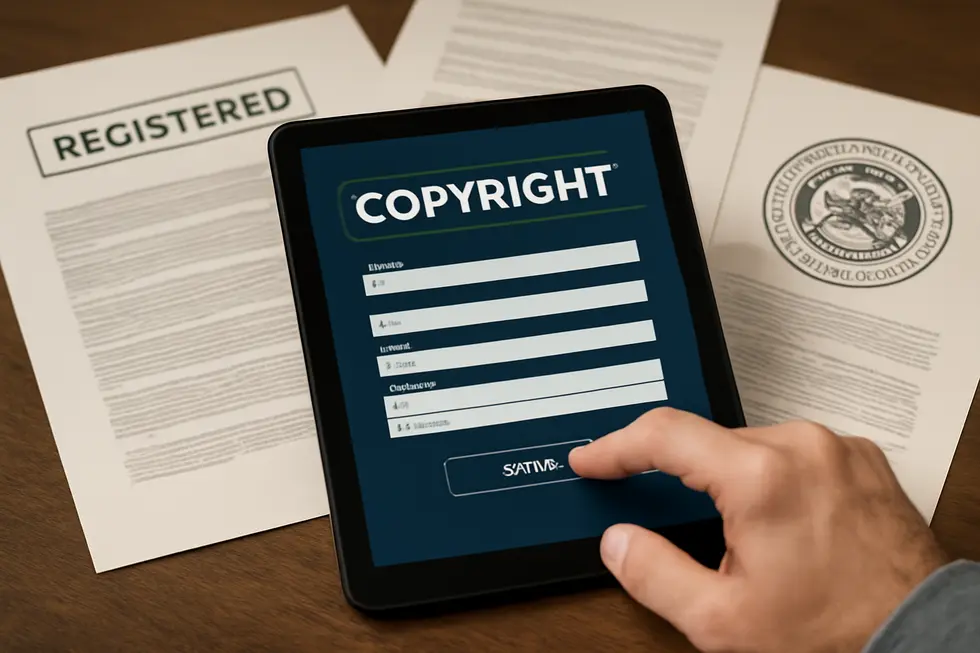
1. Unlocking Legal Strength: How Copyright Registration Empowers Website Owners
A well-crafted copyright notice serves as an important signal of ownership on a website, but formal copyright registration takes protection significantly further by delivering robust legal advantages that empower website owners. While copyright arises automatically once original content is fixed, registration solidifies ownership in the eyes of the law and enhances enforcement options.
Primary among these advantages is the presumption of validity, where a registered copyright is legally presumed to be valid. This shifts the legal burden onto any infringer disputing ownership, streamlining dispute resolution and strengthening the copyright owner’s position in court. Registration also creates a public record proving ownership, a crucial asset that simplifies enforcement by providing clear, admissible evidence to combat unauthorized use.
Notably, registration enables website owners to pursue statutory damages and recover attorney’s fees in federal infringement lawsuits—remedies unavailable without registration. These financial incentives serve as both deterrents and compensation, underscoring the seriousness of copyright protection. Additionally, courts require a copyright to be registered before a lawsuit can proceed, so registering content early ensures readiness to enforce rights swiftly if infringement arises.
Beyond enforcement, registration transforms copyrights into valuable intellectual property assets. Registered works can be licensed or sold, opening revenue streams beyond mere content display. Website owners also gain improved access to advanced monitoring tools that detect unauthorized use and facilitate takedown actions, leveraging official registrations for enforcement efficacy.
While a copyright notice alone signals ownership, pairing it with formal registration significantly amplifies legal protections and practical enforcement capabilities. This combination offers website proprietors a stronger foundation to assert and monetize their rights, effectively securing their creative investments.
For those looking to deepen their understanding of copyright registration benefits and processes, exploring expert guides such as those on benefits of copyright registration for businesses provides valuable insights. Additionally, practical steps for registration can be found through official resources explaining copyright registration procedures.
2. Mastering the Registration Process to Maximize Copyright Protection for Your Website
The process of securing enhanced protection for a copyright notice website hinges on a deliberate and structured registration procedure. This voluntary application with the U.S. Copyright Office transforms your website’s original content into a formalized legal record, bolstering your rights beyond the automatic protection granted by creation alone. It begins with careful preparation: accurately completing the application form that identifies the work—typically your website’s content or code—along with the author and publication details. This step demands precision, as omissions or inaccuracies can delay or weaken your claim.
Submitting a tangible copy of your website’s content is equally critical. This may involve digital snapshots, text files, or source code, all serving as evidence of originality and creation date. Alongside this, the payment of registration fees, generally ranging from $45 to $65 for standard electronic filings, must be completed to initiate official processing.
Once filed, your application undergoes an examination to verify compliance with legal requirements and originality standards. This review culminates in the issuance of a registration certificate, which publicly records your ownership and the date of registration. This certificate provides prima facie evidence of your copyright’s validity, dramatically easing legal disputes and proving ownership without burdensome proof.
Moreover, registration unlocks access to statutory damages and attorney’s fees during infringement litigation, tools often unavailable without it. For website owners, especially those managing dynamic or derivative content, documenting all relevant authorizations and accurately describing the work is vital to maintaining seamless protection.
By following a meticulous submission process, website owners reinforce their ability to enforce rights and deter unauthorized use, elevating the strategic value of their intellectual property. For detailed procedural guidance on registering digital works akin to websites, Aaron Hall’s comprehensive explanation offers valuable insights: https://aaronhall.com/proof-of-copyright-in-internal-software-tools/.
To further understand the benefits and best practices of copyright registration, see our detailed discussion on the benefits of copyright registration.
3. Unlocking Economic Value and Legal Power: The Impact of Copyright Registration on Website Protection
Copyright registration elevates a website’s protection by transforming its original content into a tangible legal asset. This process formalizes ownership, allowing website owners to monetize their intellectual property beyond simple display. Registered copyrights can be licensed or sold, increasing the commercial value of the website and strengthening its appeal in investment or acquisition scenarios. Licensing negotiations become more straightforward and enforceable, opening pathways for additional revenue streams from authorized third-party use.
On the enforcement front, registration provides substantial advantages that outweigh an unregistered notice. It establishes a presumption of validity in court, easing the burden on the owner to prove ownership if infringement occurs. Critically, in the United States, federal lawsuits for copyright infringement require prior registration. This legal prerequisite empowers website owners to pursue stronger remedies swiftly, including statutory damages and attorney’s fees, which can act as deterrents to potential infringers. Registration also creates a public record, enhancing credibility and signaling seriousness about content protection.
Moreover, registered copyrights facilitate proactive enforcement strategies in today’s digital environment, where unauthorized copying is rampant. Website owners can implement monitoring and automated detection systems more effectively with registered rights serving as proof of ownership. This preparedness strengthens legal standing, making enforcement and litigation more efficient if disputes arise.
Beyond litigation, copyright registration boosts the website’s reputation with users, partners, and investors by demonstrating professionalism and commitment to intellectual property protection. This fosters trust and unlocks business opportunities, whether through partnerships or content licensing.
For a comprehensive explanation of the benefits and the registration process, consult detailed resources from the U.S. Copyright Office and consider exploring strategic advantages outlined in the benefits of copyright registration for business. These insights underscore how registration is a key step toward securing and maximizing the economic and legal potential of a copyright notice website.
Chapter 4: Detailed Usage Restrictions on a Copyright Notice Website
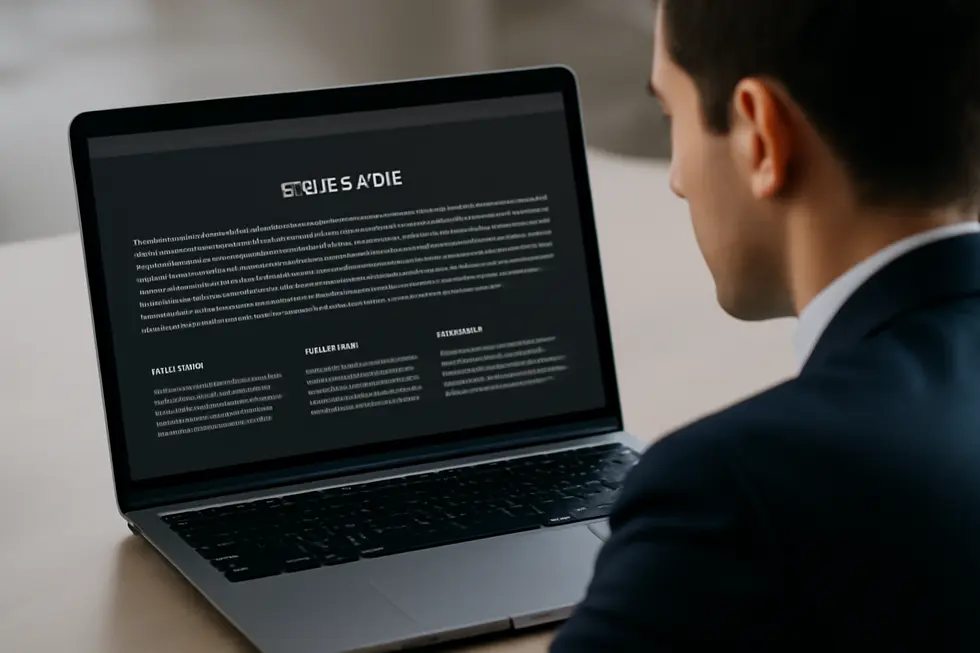
1. Clarifying Copyright Ownership and Personal Use Boundaries on Your Copyright Notice Website
A well-crafted copyright notice website communicates comprehensive ownership and usage guidelines to safeguard original content effectively. Central to this approach is the clear declaration that all website content—ranging from text and images to videos, logos, and code—is owned exclusively by the site owner or their licensors. This ownership is protected by intellectual property laws and conveyed through the © symbol, often accompanied by embedded metadata or watermarks that underscore legal attribution.
To maintain robust protection, copyright notice websites explicitly prohibit unauthorized copying, modification, redistribution, or commercial exploitation of the content unless express permission is granted. Users are forbidden from creating derivative works, adapting, reverse engineering, or using the content for defamatory or unlawful purposes. Special care is required when third-party materials appear on the site, as such content carries its own copyright terms that must be respected.
Personal use is typically allowed under strict conditions: users may view, download, or print content solely for personal, non-commercial purposes. This limited use demands retaining copyright and proprietary notices intact and providing appropriate credit when content is shared in personal or educational settings. Any use beyond personal consumption—such as redistribution or commercial reuse—requires explicit authorization or adherence to licensing agreements. Unauthorized alterations or repurposing of the materials are prohibited to preserve the content’s integrity.
Additional guidelines often address derivative works and redistribution, emphasizing the necessity of preserving original copyright notices and accurate attribution. Although certain fair use exceptions may apply, particularly for educational and nonprofit contexts, these must be carefully evaluated considering factors like purpose, amount used, and market impact.
Moreover, while copyright exists automatically upon creation, registering the content with the U.S. Copyright Office strengthens the legal position of owners and enhances enforcement capabilities in the event of infringement. This structured framework not only protects intellectual property but also informs users of responsible usage and the limitations tied to personal and public use. For a more detailed process on registering copyrights, see resources such as QuickSprout’s guide on how to copyright a website.
For further understanding of how copyrights protect creative works broadly, the article on copyright protection for books, movies, and songs offers valuable insights.
2. Navigating Prohibited Actions and Fair Use Boundaries in Website Copyright Notices
A well-crafted copyright notice on a website serves not only to assert ownership but also to outline clear usage restrictions that safeguard content against unauthorized exploitation. Typically, these notices specify precise prohibitions that users must respect to preserve the creator’s rights. Core forbidden actions include any commercial use of the content without prior authorization, as this directly impacts the owner’s market opportunities. Likewise, altering, modifying, or producing derivative works from the original content—such as translations, adaptations, or reverse engineering—are expressly forbidden to prevent unauthorized distortions or misrepresentations of the work.
Additionally, copyright notices commonly prohibit the removal or obscuring of legal markers like © symbols, trademark identifiers, or proprietary watermarks embedded in the content. These markers authenticate ownership and help maintain legal protections. Any illegal or defamatory use, including content employed to discriminate or offend, is also barred, reinforcing ethical and lawful engagement with protected materials.
Alongside these restrictions, detailed copyright notices acknowledge the doctrine of fair use, which permits limited and qualified exceptions. Fair use typically applies to non-commercial, educational, or personal settings where a small portion of the work may be used for commentary, criticism, or scholarly purposes without explicit permission. This balance ensures that valuable content remains accessible for transformative or beneficial uses while safeguarding the creator’s interests. The extent of permitted use depends on factors such as the purpose, nature, portion used, and market impact of the use. Users should always ensure attribution and seek guidance when fair use boundaries are uncertain.
For example, educators may leverage fair use or statutory exceptions like the TEACH Act to incorporate copyrighted materials into curricular activities without direct authorization, provided the usage remains supervised and aligned with instructional goals.
By explicitly detailing both prohibited actions and fair use allowances, copyright notices on websites refine visitor understanding of permissible conduct and reinforce the content owner’s legal rights. For deeper guidance on copyright policies relevant to websites, consult comprehensive resources such as the Economic and Media University Copyright Guide, which provides practical insights into usage boundaries and protections.
For further elaboration on securing intellectual property, reviewing best practices for copyright protection can offer valuable context, illustrating broader strategies to defend creative works online.
3. Navigating Third-Party Content Licensing and Attribution in Website Usage Restrictions
When incorporating third-party content such as images, fonts, or audio in a website, clear licensing and attribution are essential. These components often carry specific legal terms that dictate how the content may be used, modified, or shared. A properly detailed usage restriction section must identify each third-party asset with its corresponding license, ensuring compliance and transparency.
Typically, website owners include a dedicated file—often named Third-Party Notices.txt—listing all third-party materials and their underlying licenses. This file should be readily accessible within the website directory or linked from the footer, providing visitors or users detailed information about each asset’s permissible uses. Full license texts or summaries should accompany these listings, clarifying conditions such as commercial use allowances or modification permissions.
Many popular licenses, such as Creative Commons variants, require explicit attribution to the original creators. The website’s usage restrictions should communicate these requirements clearly, specifying how credits should be displayed and indicating which parts of the site employ such third-party works. Failure to meet these obligations risks license violations, which can expose the website owner to legal challenges.
Maintaining thorough records of all licenses and permissions acquired for third-party content is crucial. This not only demonstrates good faith compliance but also serves as legal evidence should disputes arise. Furthermore, reviewing each license’s terms carefully ensures that prohibited activities—like unauthorized commercial use or derivative works—are explicitly restricted in the usage guidelines.
Including such detailed licensing and attribution protocols within a copyright notice website strengthens intellectual property respect and safeguards the site owner’s position. For added insight into managing third-party licenses responsibly, refer to this guide on licensing third-party content.
For broader context on enforcing copyrights and protecting website content, the article on copyright protection for books, movies, and songs offers valuable guidance.
Chapter 5: Best Practices for Implementing a Copyright Notice Website and Enforcement
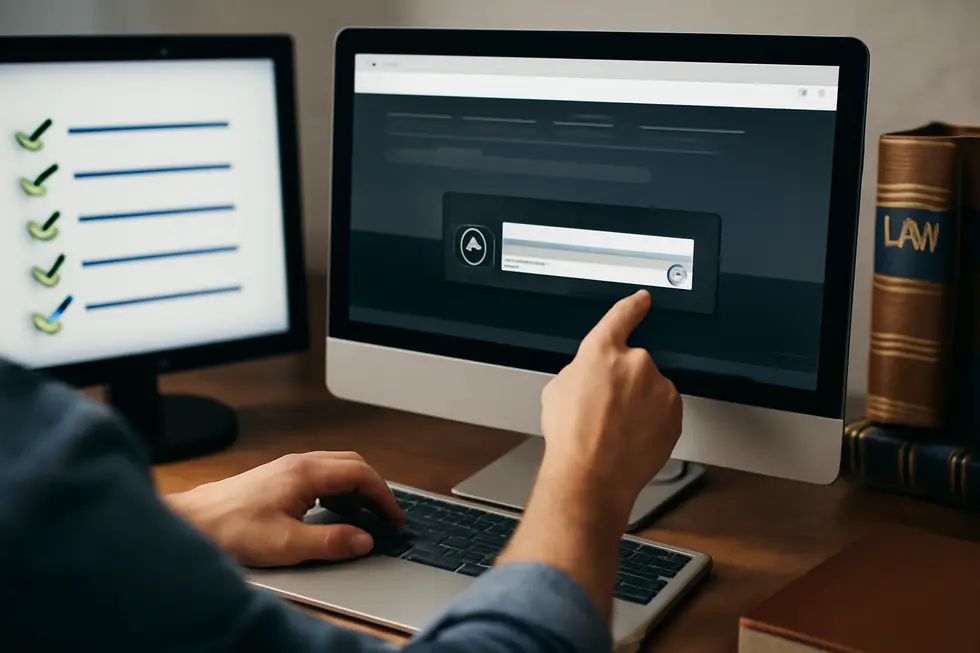
1. Establishing Clear Ownership and Robust Legal Defenses Through Strategic Copyright Notices
Implementing an effective copyright notice on a website goes beyond merely displaying a symbol; it demands a strategic combination of clear ownership declaration, proactive safeguards, and legal preparedness. Typically positioned in the footer, the copyright notice should unmistakably present the © symbol, the year of first publication, and the copyright owner’s name—for example, © 2025 Your Company Name. While U.S. law no longer requires this notice, its presence serves as a visible deterrent to unauthorized usage and helps negate claims of innocent infringement by signaling that content is protected.
To further strengthen legal protection, pairing the copyright notice with a detailed Terms of Use or Terms and Conditions page clarifies what users may or may not do with the website’s content. This page should explicitly outline permissions, restrictions, and consequences related to unauthorized copying, modification, or redistribution. Linking this policy near the notice increases its visibility, enhancing the site’s enforceability stance.
Beyond declarations, proactively safeguarding content is critical. Watermarking images with subtle but persistent marks discourages theft and reinforces branding. Equally important is maintaining thorough documentation: retaining original files with clear timestamps, metadata, and written agreements with content creators establishes a firm evidentiary trail. This documentation becomes invaluable when responding to infringement, such as issuing DMCA takedown notices or pursuing formal legal actions.
Timely monitoring through reverse image searches and plagiarism tools enables swift detection of unauthorized uses. Understanding legal processes around DMCA notices—when to comply, when to counter-notice—and having contracts in place with contributors further fortify enforcement capabilities.
Together, these practices create a layered defense where visible ownership signals meld with documented rights and ongoing vigilance, preparing website owners to assert and protect their intellectual property effectively.
For an in-depth guide to protecting images and strengthening copyright notices, consider resources like Elementor’s image protection strategies. Additionally, explore how formal copyright registration benefits businesses at Benefits of Copyright Registration for Business.
2. Integrating Technical Measures and Legal Tools to Strengthen Copyright Protection on Your Website
Establishing effective legal protection for website content goes beyond displaying a copyright notice—it demands a strategic integration of visible markers, technical safeguards, and formal enforcement mechanisms. A clear, legible copyright notice placed prominently, typically in the footer, should always include the © symbol, the initial publication year, and the copyright owner’s name. This simple but essential step signals ownership and discourages unauthorized use by making protection status explicit to every visitor. Updating the year regularly underscores ongoing vigilance.
To complement this, embedding watermarking on images offers a visual deterrent; semi-transparent marks strategically placed prevent covert copying without disrupting user experience. Alongside watermarking, implementing digital rights management (DRM) technologies is crucial for controlling content distribution. DRM encrypts assets and manages licenses, ensuring only authorized users can access or share the protected material. Its role is particularly important for multimedia elements like videos and proprietary code.
Beyond these direct protections, crafting a comprehensive Terms of Use page clarifies permitted content use and outlines consequences of infringement. Linking this page near the copyright notice reinforces legal clarity and visitor awareness. Proactive enforcement can leverage automated detection tools powered by machine learning to scan the internet for unauthorized reproductions, enabling swift takedown requests through platform partnerships.
Crucially, formal registration of website content with the U.S. Copyright Office strengthens legal standing and facilitates enforcement actions if violations occur. This procedural step grants exclusive rights recognized by courts and deters infringement through potential legal consequences.
The holistic combination of visible notices, watermarking, DRM, clear usage policies, automated monitoring, and formal registration cultivates a robust defense for website content. For more detailed guidance on protecting digital assets, consult authoritative sources such as Aaron Hall’s best practices on enforcing copyrights in digital markets.
To explore strategic legal protections that complement these technical measures, see also our discussion on benefits of copyright registration for businesses.
3. Strengthening Website Copyright Protection: From Notice to DMCA and Legal Enforcement
A robust approach to protecting your website’s intellectual property begins with clear presentation and extends to diligent enforcement. A prominent copyright notice—typically in the footer—should include the © symbol, the current year, and the copyright holder’s name. While this notice is no longer legally mandatory, it actively signals your claim of ownership and helps reduce accidental infringements. Complementing this, a detailed Terms of Use page clarifies permitted content use and the consequences of violations, reinforcing your legal position.
Digital media like images can benefit from added protective layers such as subtle watermarks and embedded metadata. These measures discourage unauthorized use and preserve proof of ownership, as altering metadata is prohibited under the DMCA. Should infringement occur, carefully documenting each violation is critical. This involves capturing screenshots, recording URLs, and noting timestamps, establishing clear evidence to support your claims.
Initial enforcement often takes the form of a cease and desist letter, informing the infringer of their violation and demanding removal. If this fails, leveraging the DMCA takedown process is an effective next step. Submitting a correctly formatted DMCA notice to the platform hosting the infringing content can prompt swift removal, protecting your rights with minimal cost.
In cases where informal actions and takedown requests do not resolve the issue, consulting an intellectual property attorney can help assess litigation possibilities. Legal action may recover damages but requires consideration of expenses and potential outcomes.
Maintaining updated copyright notices and policies, educating your team and visitors, and preserving creation and registration records all contribute to a strengthened defense. This comprehensive strategy—from visible notices to formal enforcement—maximizes protection and provides means to respond decisively to infringement.
For detailed guidance on drafting DMCA takedown notices and enforcement procedures, see the step-by-step process from PatentPC here.
For more on securing your copyright and using clear website policies, explore this copyright notice guide for businesses.
Final thoughts
Safeguarding your website with a properly crafted copyright notice goes beyond mere formality—it establishes a proactive legal stance that protects your original business content. By crafting a notice with the essential elements, leveraging the legal advantages under U.S. law, registering your copyrights for stronger claims, incorporating clear usage restrictions, and following best implementation practices, business owners can significantly reduce the risks of infringement and unauthorized use. This multifaceted approach ensures that your intellectual property remains secure and that your brand’s online presence is legally fortified. Taking these steps equips your business with peace of mind and stronger recourse options if disputes arise.
Get your trademark today! Thousands have protected their brand by filing a trademark. What are you waiting for? Start your trademark application!
About us
The globe’s top website for registering trademarks and safeguarding your brand, name, logo, or slogan.
